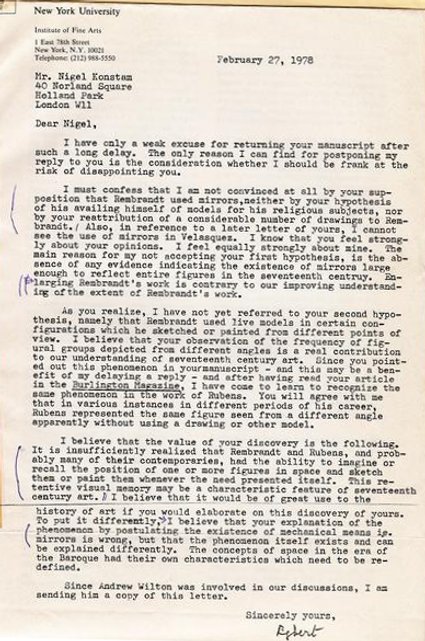See below for transcript for ease of reading

New York Univerersity
Institute of Fine Arts
1 East 78th Street
New York
N.Y.10075
Mr Nigel Konstam
40 Norland Square
Holland Park
London W11
February 27, 1978
Dear Nigel,
I have only a weak excuse for returning your manuscript after such a long delay. The only reason I can find for postponing my reply to you is the consideration whether I should be frank at the risk of disappointing you.
I must confess that I am not convinced at all by your supposition that Rembrandt used mirrors, neither by your hypothesis of his availing himself of models for his religious subjects, nor by your re-attribution of a considerable number of drawings to Rembrandt. Also, in reference to a later letter of yours, I cannot see the use of mirrors in Velasquez. I know that you feel strongly about your opinions. I feel equally strongly about mine. The main reason for my not accepting your first hypothesis, is the absence of any evidence indicating the existence of mirrors large enough to reflect entire figures in the seventeenth century. Enlarging Rembrandt’s work is contrary to our improving understanding of the extent of Rembrandt’s work.
As you realize, I have not yet referred to your second hypothesis, namely that Rembrandt used live models in certain configurations which he sketched or painted from different points of view. I believe that your observation of the frequency of figural groups depicted from different angles is a real contribution to our understanding of seventeenth century art. Since you pointed out this phenomenon in your manuscript – and this may be a benefit of my delaying a reply – and after having read your article in the Burlington Magazine, I have come to learn to recognize the same phenomenon in the work of Rubens. You will agree with me that in various instances in different periods of his career, Rubens represented the same figure seen from a different angles apparently without using a drawing or other model.
I believe that the value of your discovery is the following. It is insufficiently realized that Rembrandt and Rubens, and probably many of their contemporaries, had the ability to imagine or recall the position of one or more figures in space and sketch them or paint them whenever the need presented iself. This retentive visual memory may be a charcteristic feature of seventeenth century art. I believe that it would be of great use to the history of art if you would elaborate on this discovery of yours. To put it differently. I believe that your explanation of the phenomenon by postulating the existence of mechanical means in mirrors is wrong, but that the phenomenon itself exists and can be explained differently, the concepts of space in the era of the Baroque had their own characteristics which need to be redefined.
Since Andrew Wilton was involved in our discussions, I am sending him a copy of this letter.
Sincerely yours,
Egbert
